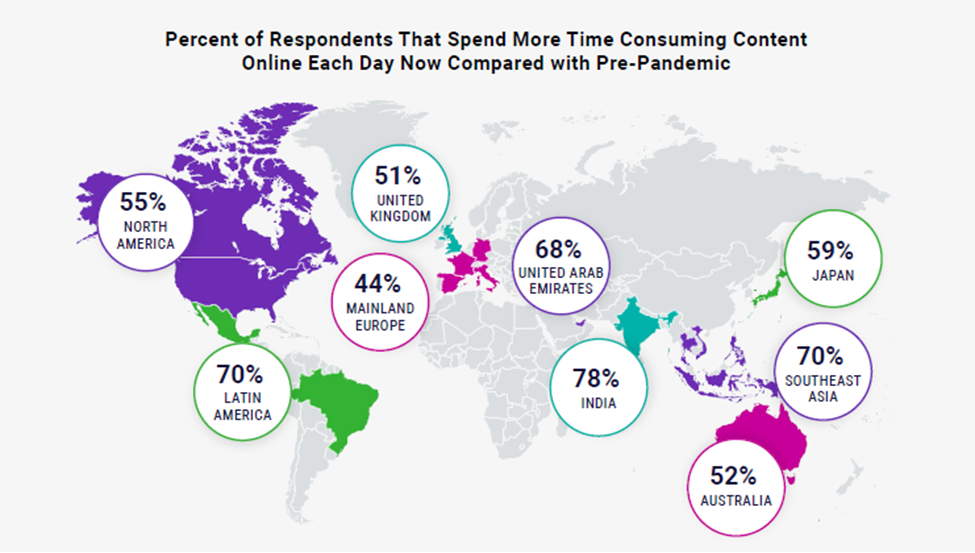Guide To Digital Rights Management (DRM): A 10-Step Checklist
The consumption of digital content has reached all-time highs. According to DoubleVerify’s report, Four Fundamental Shifts in Advertising and Media, 55% of people in North America report still spending more time consuming digital content as in 2019.

Source: DoubleVerify
In response to this growing demand, marketing and advertising teams are generating more and more digital content to feed the frenzy. While Digital Asset Management (DAM) systems are the price of doing business today, many organizations lack the Digital Rights Management (DRM) component that protects them from costly lawsuits, overage fees, and bad press associated with misusing copyrighted content.
Many brands use DAM metadata fields to manage rights, but with the growing volume of digital content, the limitations of metadata make it impossible to effectively keep track of asset rights.
In this article, we provide a 10-step checklist to create an effective digital rights management strategy. But first, let’s clarify what DRM is and why it’s important.
What is Digital Rights Management, and Why Is It Important?
Creative content is often comprised of licensed assets and/or contracted talent. License terms and talent agreements can stipulate all kinds of factors, including regional use, channel use, expiration dates, and restrictions.
Digital Rights Management is a best practice that gives organizations visibility into their owned and licensed assets using gatekeeping tools to ensure usage complies with the agreed-upon terms. Digital Rights Management technology supports this process, integrating with ancillary systems and automating rights clearance to support efficiency and compliance throughout the campaign and content production lifecycle, from planning through production to post-distribution. A clearance check verifies if content can be used according to the campaign criteria and based on overall usage rights.
A solid DRM process is important because unauthorized use or usage outside of contract terms can put brands at risk. Benefits of implementing DRM software and processes include:
- mitigating the risk of copyright infringement and litigation,
- protecting a brand’s reputation and financial interests,
- keeping production costs on budget and
- ensuring that assets are used in a way that is consistent with the brand’s overall marketing strategy.
We have put together the following 10-step checklist to help you reap these benefits.

DRM 10-Step Checklist for Protecting Your Digital Content
1. Inventory Your Content and Agreements
Inventory the type of content that is rights-managed and understand where the rights are coming from.
- Are the rights tied to license agreements or talent contracts?
- Does the content contain elements that are being governed by more than one contract, for example, multiple models or differently licensed content?
- Who in your organization owns the various contracts and rights? You will need to know that in order to gather all the associated agreements.
- Do you have rights information from your agencies?
- Are contracts paper or electronic?
By taking inventory, you’ll be able to ensure there are no gaps in your information.
2. Centralize Rights Information
When rights are centralized and accessible across the production workflow, all stakeholders are empowered to make informed decisions, while legal teams are armed to defend the usage and protect the reputation of the brand and company. As part of this exercise, you will need to understand:
- What types of systems are part of your production workflow, from planning to production to distribution? Any of these systems might need to check rights before clearing an asset for use.
- Who needs to have visibility into the information? Identifying these roles upfront will make your workflow easier and more efficient, especially when working collaboratively.
- Are there processes in place for cataloging rights for an asset at acquisition? Establishing an asset ingestion process and capturing as much data as possible at the beginning of the process will reduce both risk and maintenance efforts and improve reuse. It is much harder to come back later and get the rights data necessary to clear the asset.
Centralizing rights data can also help you save on contract and licensing fees, as the team can amend and extend agreements on content rather than produce or acquire from scratch.

3. Ensure Rights Management Is Part of Your Governance Process
Any large organization or brand will have a multi-faceted governance process in place. Look at how the plan and process intersect rights management to ensure content is used within regulation. The aim is to be able to manage content globally across all potential users, brands, channels, and territories.
We recommend looking at how your governance processes empower your teams to manage content globally, while ensuring the content is used within regulation and/or according to contracts. For example, do all asset uploads require rights information capture? Are you allowed to download assets without proper rights? Do you allow regional teams to modify brand assets? What do you require of your agencies?
By adding a rights verification step during production, monitoring content consumption, and tracking against expirations, companies gain content compliance that will save millions in litigation costs and protect brand reputation. You should invest in governance across the full lifecycle to effectively manage content.
4. Determine Where You Need a Rights Check Across Your Content Supply Chain
Access to rights checks is necessary throughout your content lifecycle, from production and planning to distribution and publishing. It’s important to check rights before a campaign is live but also to monitor for expirations and usage rights after the campaign has launched.
Adding in one or more rights verification steps can empower the business user across the overall workflow – from campaign planning to asset management to creative processes and finally post-distribution. Say, for example, that the contract for a model used in an asset within your campaign expires. That asset is no longer compliant and can cause your firm damage, both financially and reputationally.
This system for checks and balances will ensure compliance for your assets and talent agreements.
5. Integrate Digital Rights Management Technology with Your 3rd-Party Systems
Now that you have identified where your rights clearance checks need to be across the content lifecycle, make sure your digital rights management technology is integrated with your enterprise-wide processes and systems. Ensuring that your DRM is open and extensible is key.
- Integrate into your planning and workflow management tools
- Plug rights, restrictions, and expirations into your DAM, MAM, or CMS
- Automate rights verification pre-distribution through your PIM, e-commerce, and social media platforms.
- Perform in-app rights checks within your creative tools, such as Adobe Creative Cloud and Figma.
- Coordinate clearance and usage tracking post-distribution with rights information to prevent violations. For further visibility, we recommend investing in a content tracking solution to stay up to date as to where, when, and how your assets are being used. Keeping an eye on the digital assets you’re utilizing across advertisements, branding, and content enables you to be aware of content misuse before it causes problems.

6. Carve Out a Librarian Role
A librarian’s responsibility is to maintain content and its integrity, manage rights to ensure compliance, and promote the efficient use and reuse of existing investments. In today’s digital age, a librarian is a must-have for a large brand. With digital content being created at a speed and quantity exponentially higher than non-digital content, there are new concerns and responsibilities for librarians, making the role essential.
7. Create a Well-Designed Taxonomy
Taxonomy is essential when working with assets and content as a way of properly classifying and cataloging. Ensure that you consider all your points of sale as well as how an asset might be leveraged across products and brands so that you are able to properly acquire and track rights. Often, licensing agreements are bounded with exclusions, restrictions, timeframes, geographic limitations, and more. In addition, assets themselves are becoming more complex. An asset is no longer necessarily a singular item but instead is now becoming a “composite asset,” comprised of multiple media items forming one new asset. It is important to employ a flexible and extensible model which allows you to track different types of assets (text, images, video, music, brands, etc.) in different ways (formats, territories, usage types, components, exclusivity, date windows, etc.). Ideally a place to store pre-production assets with rights and then compose final assets that inherit the rights.
8. Automate Rights Management
Some companies use a manual approach involving spreadsheets, file folders, or attaching PDF contracts. As assets proliferate and agreements become more granular, such an approach can soon become too complex to manage and maintain. For this reason, it is advisable to automate the rights clearance step so that users are empowered and brands are protected. Otherwise, there is a risk of encountering a variety of functional limitations:
- An asset is often associated with multiple talent(s) or other agreements that may have different rights that need to be accounted for.
- A contract or asset with one talent may have different expiration dates for different distribution channels.
- Each time a contract is updated, affected assets need to be identified and metadata must be updated manually.
- There is no guarantee that users will check the usage rights metadata field and interpret it correctly.
9. Introduce Rights-Driven Workflow
Introducing a rights-based workflow is a very interesting concept that typically suits organizations that are further along in their DAM maturity models.
Consider triggering behavior based on rights results. For instance, if a content piece cannot be used according to the bounds of a particular campaign, then prevent it from being downloaded, throw up a disclaimer, or stamp it with a watermark. This can only be done properly if the content and associated rights are tied together during the production process, at the point of selection for use.
You can also introduce process efficiencies with workflow tasks and business process management, such as requesting additional rights for a content piece in order to meet content and brand objectives. Additionally, one can look to drive notifications and alerts based on content intelligence, such as when content or agreements expire, where one might be in violation, and when a buyer enters the last stage of their experience. Or even trigger takedowns.
10. Provide Reporting and Analytics
Visibility into what content is available and its associated rights is critical during the production process. It provides transparency, compliance, and trending that can be used across the organization to both protect your brand and seek out new opportunities.
With useful reporting and analytics, legal teams are armed to defend the usage of content. Buyers can negotiate better licensing terms and talent rates. Marketing teams can keep track of content across the lifecycle to proactively handle impending expirations, negotiate extensions, and immediately address violations.
How FADEL Can Help Enhance Your DRM Practices
FADEL pioneered digital rights management technology, creating a rights and royalty management system for Marvel Entertainment back in 2005 when even the media giants were struggling to manage IP contracts. Since then, we have stayed ahead of the curve, building fit-for-purpose software that meets the growing demands of organizations in today’s digital age. Our cloud-based platform, Brand Vision, gives companies all the tools they need to ensure compliant use of brand assets, product packaging, marketing content, and advertising. Brand Vision provides:
- a place to store pre-production assets with rights
- the ability to composite assets that inherit rights
- a workflow engine for business process automation
- the clearance check
- an open and extensible API
With at-a-glance visibility into content usage rights, teams can quickly and easily identify available content as well as when, where, and how it can be used to:
- Speed content production
- Increase efficiencies
- Maximize content reuse
- Protect brand equity
In addition, Brand Vision comes with content tracking capabilities that automatically find published images across brand, e-commerce, social, and partner websites.
Are you ready to take your DRM to the next level? Contact FADEL today for a demo.

